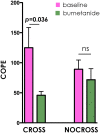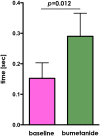Bumetanide for autism: more eye contact, less amygdala activation
- PMID: 29483603
- PMCID: PMC5827728
- DOI: 10.1038/s41598-018-21958-x
Bumetanide for autism: more eye contact, less amygdala activation
Abstract
We recently showed that constraining eye contact leads to exaggerated increase of amygdala activation in autism. Here, in a proof of concept pilot study, we demonstrate that administration of bumetanide (a NKCC1 chloride importer antagonist that restores GABAergic inhibition) normalizes the level of amygdala activation during constrained eye contact with dynamic emotional face stimuli in autism. In addition, eye-tracking data reveal that bumetanide administration increases the time spent in spontaneous eye gaze during in a free-viewing mode of the same face stimuli. In keeping with clinical trials, our data support the Excitatory/Inhibitory dysfunction hypothesis in autism, and indicate that bumetanide may improve specific aspects of social processing in autism. Future double-blind placebo controlled studies with larger cohorts of participants will help clarify the mechanisms of bumetanide action in autism.
Conflict of interest statement
N.H., E.L. and Y.B.-A. are founders and shareholders of Neurochlore, a biotech company dedicated to the development of novel therapies for autism and other developmental disorders.
Figures



Similar articles
-
Improving emotional face perception in autism with diuretic bumetanide: a proof-of-concept behavioral and functional brain imaging pilot study.Autism. 2015 Feb;19(2):149-57. doi: 10.1177/1362361313514141. Epub 2013 Dec 16. Autism. 2015. PMID: 24343334
-
NKCC1 Chloride Importer Antagonists Attenuate Many Neurological and Psychiatric Disorders.Trends Neurosci. 2017 Sep;40(9):536-554. doi: 10.1016/j.tins.2017.07.001. Epub 2017 Aug 14. Trends Neurosci. 2017. PMID: 28818303 Review.
-
Effects of bumetanide on neurodevelopmental impairments in patients with tuberous sclerosis complex: an open-label pilot study.Mol Autism. 2020 May 7;11(1):30. doi: 10.1186/s13229-020-00335-4. Mol Autism. 2020. PMID: 32381101 Free PMC article. Clinical Trial.
-
A randomised controlled trial of bumetanide in the treatment of autism in children.Transl Psychiatry. 2012 Dec 11;2(12):e202. doi: 10.1038/tp.2012.124. Transl Psychiatry. 2012. PMID: 23233021 Free PMC article. Clinical Trial.
-
Pharmacological tools to target NKCC1 in brain disorders.Trends Pharmacol Sci. 2021 Dec;42(12):1009-1034. doi: 10.1016/j.tips.2021.09.005. Epub 2021 Oct 4. Trends Pharmacol Sci. 2021. PMID: 34620512 Review.
Cited by
-
Reading the room: Autistic traits, gaze behaviour, and the ability to infer social relationships.PLoS One. 2023 Mar 1;18(3):e0282310. doi: 10.1371/journal.pone.0282310. eCollection 2023. PLoS One. 2023. PMID: 36857369 Free PMC article.
-
Neuroendocrine, epigenetic, and intergenerational effects of general anesthetics.World J Psychiatry. 2020 May 19;10(5):81-94. doi: 10.5498/wjp.v10.i5.81. eCollection 2020 May 19. World J Psychiatry. 2020. PMID: 32477904 Free PMC article. Review.
-
Design, Synthesis, In Vitro and In Vivo Characterization of Selective NKCC1 Inhibitors for the Treatment of Core Symptoms in Down Syndrome.J Med Chem. 2021 Jul 22;64(14):10203-10229. doi: 10.1021/acs.jmedchem.1c00603. Epub 2021 Jun 17. J Med Chem. 2021. PMID: 34137257 Free PMC article.
-
Treatment Effect of Bumetanide in Children With Autism Spectrum Disorder: A Systematic Review and Meta-Analysis.Front Psychiatry. 2021 Nov 15;12:751575. doi: 10.3389/fpsyt.2021.751575. eCollection 2021. Front Psychiatry. 2021. PMID: 34867539 Free PMC article.
-
An Update on Psychopharmacological Treatment of Autism Spectrum Disorder.Neurotherapeutics. 2022 Jan;19(1):248-262. doi: 10.1007/s13311-022-01183-1. Epub 2022 Jan 14. Neurotherapeutics. 2022. PMID: 35029811 Free PMC article. Review.
References
-
- Johnson, M. & Morton, J. Biology and cognitive development: the case of face recognition. (Blackwell, 1991).
Publication types
MeSH terms
Substances
LinkOut - more resources
Full Text Sources
Other Literature Sources

